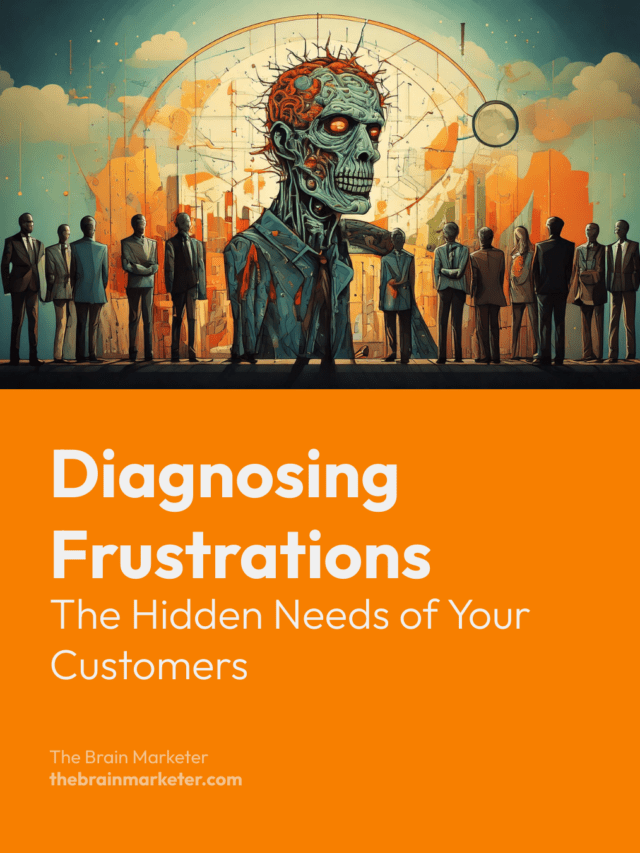Diagnosing customer frustrations is essential for designing solutions that genuinely meet expectations. These hidden tensions often explain churn, dissatisfaction, or disengagement. Understanding them requires a deep dive into the customer profile, the perceived value of your offer, and your competitive positioning. This article explores how to diagnose these frustrations using qualitative research techniques, active listening, and the 10th Man Rule. Once revealed, frustrations become powerful entry points for differentiation.
Key Takeaways
- Frustrations often stem from unmet emotional or functional needs.
- Qualitative research methods uncover insights that surveys alone can’t detect.
- The primal brain amplifies frustration when basic needs (security, control, clarity) aren’t met.
- The 10th Man Rule prevents blind spots by challenging internal consensus.
- Brands that actively resolve frustration build loyalty and reduce churn.
🎙️ Unpack the Topic with this Podcast
Understanding and Diagnosing Customer Frustrations
There is no universal formula for identifying frustrations. It requires both analytical rigor and empathy. Here’s how marketers can dig beneath the surface:
1. Semi-Structured Interviews and Focus Groups
These qualitative methods help uncover frustrations by creating space for honest, unfiltered expression.
- Semi-structured interviews offer flexibility while exploring key themes.
- Focus groups reveal shared pain points that individuals may not express alone.
Example: In the automotive industry, recurring frustrations such as long delivery times or complex pricing structures often emerge during open group discussions.
2. Deep Dive into the Value Proposition
Move beyond listing features. Ask:
- What elements of our offer generate satisfaction or irritation?
- Which promises are clearly understood and which remain vague?
- Does our product solve a customer frustration, or inadvertently create a new one?
Mapping these perceptions helps align your message with real expectations.
3. The Primal Brain and Survival Triggers
The primal brain (responsible for our survival instincts) amplifies discomfort in uncertain situations. When a purchase decision feels risky, consumers may experience stress. This stress is often mistaken for hesitation, though it reflects a defensive response.
Marketing insight: Reduce complexity. Emphasize safety, speed, and ease of use. These cues calm the primal brain and minimize decision-making friction.
The 10th Man Rule: Consider Dissenting Voices
To avoid marketing myopia (seeing only what confirms our assumptions) marketers must embrace contrarian thinking. That’s where the 10th Man Rule comes in.
Originating from the film World War Z, the 10th Man Rule states that if nine people agree on a strategy, the tenth must actively challenge it. This ensures the team explores risks, flaws, and overlooked assumptions.
Application: If your team believes that fast delivery isn’t a customer priority, a 10th man might highlight how vague or delayed delivery times generate major dissatisfaction.
This mental model introduces constructive friction and encourages broader thinking.
Case Study: Domino’s Pizza and Delivery Frustration
Domino’s turned a common frustration into a strategic differentiator. Customers were annoyed by unpredictable delivery.
Their solution: a bold promise—”Delivered in 30 minutes or it’s free.” This clear, time-bound commitment directly addressed customer concerns. It transformed uncertainty into trust and elevated the brand’s reputation.
Questions to Identify Frustrations
To uncover the root causes of customer frustration, ask:
- What is the primary source of this frustration?
- How intense is it—mild annoyance or deep emotional discomfort?
- Is it urgent? Does it hinder action or decisions?
- Is the customer aware of it, or is it subconscious?
This framework helps prioritize which frustrations to address first.
Typology of Frustrations
| Type | Origin Example | Intensity | Urgency | Awareness Level |
|---|---|---|---|---|
| Financial | Unexpected fees, price opacity | High | High | Often explicit |
| Strategic | Low stock, quality inconsistency | Medium | Medium | Recognized when recurring |
| Personal/Emotional | Lack of control, stress | Variable | High | Often implicit |
Understanding the emotional weight behind each type of frustration allows marketers to adapt messaging and improve experience design.
Strategies to Reduce Frustration
- Active Listening: Create opportunities for open dialogue and real feedback.
- Proactive Solutions: Anticipate common pain points such as delays or unclear return policies.
- Radical Clarity: Make your value proposition transparent, simple, and easy to trust.
These strategies reduce perceived effort, foster trust, and enhance satisfaction.
Conclusion
Frustrations are not noise, they are strategic signals. By applying qualitative methods and embracing dissent through the 10th Man Rule, marketers gain deeper insight into what customers truly need. This unlocks opportunities to improve product design, sharpen communication, and foster long-term loyalty. Brands that master the art of diagnosing customer frustrations don’t just stand out, they stay relevant.
Sources
- Patrick Renvoisé, Neuromarketing: Understanding the Buy Buttons in Your Customer’s Brain, 2007
- Gerald Zaltman, How Customers Think, 2003
- Film reference: World War Z (2013) – concept of the “10th Man Rule”
- Harvard Business Review – “The Hidden Causes of Customer Frustration” by Matthew Dixon and Nick Toman, 2019

Vincent Heimann is a marketing project manager and neuromarketing enthusiast. He founded The Brain Marketer to bridge neuroscience and marketing through accessible, science-based content. With over 10 years of experience in digital strategy, UX/UI and communication, he shares practical insights to help brands connect with the human brain — ethically and effectively

